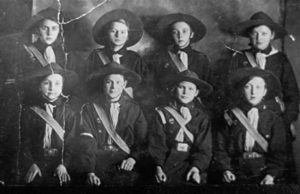
Picture from city of Durham archives
I’m currently working on an exhibition for Girl Museum¬†about youth groups for girls. Part of it will look at the history of girl groups, so I wanted to write a short blog post as a taster for the real thing! This post looks at how the first girl group, the Girl Guides, came to be.
To start off, we need to think about the boy’s group. The first really popular youth group, the Scout movement, was started in the UK by Robert Baden-Powell in 1907. Baden-Powell was an ex-army general, who had developed the ideas for his boy’s movement based upon his military background and sense of patriotism and Christianity. He wrote many military books, including Scouting for Boys, aimed at children, and toured around the country drumming up support for his ideas of a scouting movement, which he believed would turn boys into model citizens.
The time period this all began in is important to consider. Britain was at the peak of its Empire; laws from the previous century had banned child labour and meant that all children had to go to school; the coming of the Industrial Revolution meant that roles were more divided, and some had more leisure time; and Britain was becoming more secular, which caused a moral panic in some members of society, including, it could be argued, Robert Baden-Powell.
The first Scout Rally was held in Hyde Park, London in 1909. There, Baden-Powell was confronted with a number of girls who had dressed up in scout uniform, and were calling themselves “girl scouts”.
Seeing a demand for girls’ involvement in scouting, but not wanting to dilute the moral message he was putting across with the Boy Scouts, (which was largely reliant on a gender divide), Baden-Powell worked with his sister Agnes Baden-Powell to set up the Girl Guide movement.
The Girl Guide movement had equally military origins – they were named for a group of “Guides” who patrolled the North-West Frontier in India (now Pakistan). Like the Scouts, they too wore a uniform, and worked to earn badges. Most girls were satisfied with this change and chose to become Girl Guides, in the absence of being Scouts.
The photograph above is of eight Girl Guides from Easington Colliery, County Durham. It is believed to have been taken in 1912, which makes it one of the first photographs of a group of Girl Guides.
Girl Guides has grown a huge amount up to 2016, and now has over 500,000 members, outnumbering the Scouts. Stay tuned for more updates on how the girl groups exhibition is coming along soon!
-Jocelyn Anderson-Wood
Junior Girl
Girl Museum Inc.

There are several inaccuracies in the peice above – I’d be happy to help with advice/input/corrections.
Hi L! Our team has reached out to you to discuss your concerns. Please note that these blogs are only meant to be a very brief introduction to the history of Girl Guides, which we are researching for an upcoming exhibition. We’re curious to see what sources you’ve found that might dispute what we’ve learned so far. Thank you!
Hello! Glad to see someone is doing something like this. I’m a Girl Guide Leader in Australia, currently working on my Masters in the history of the Girl Guide uniform downunder, and working on my own exhibition in the lead up to our New South Wales Centenary in 2020. We are finding a great deal about our history in the process of this, including about the fallacy of the Crystal Palace legend. Happy to help out!
Hi Elizabeth! Thanks for commenting. We’re also working on an exhibition about Girl Guides and related girls’ groups for next year. Our curator will be emailing you to discuss whether you’d like to be involved! Hope to hear from you.